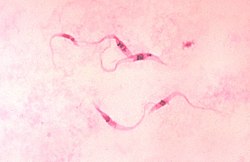トリパノソーマ科
トリパノソーマ科︵トリパノソーマか、学名: Trypanosomatidae︶は、キネトプラスト綱に属し1本の鞭毛を持つ原生生物からなる分類群である。全てが寄生虫であり、基本的には昆虫を宿主としているが、生活環の中で脊椎動物や植物などの中間宿主に寄生するものが知られている。この1科をもってトリパノソーマ目 Trypanosomatida またはトリパノソーマ亜目 Trypanosomatina を構成する。
| トリパノソーマ科 | |||||||||||||||||||||
|---|---|---|---|---|---|---|---|---|---|---|---|---|---|---|---|---|---|---|---|---|---|
 クルーズトリパノソーマ Trypanosoma cruzi | |||||||||||||||||||||
| 分類 | |||||||||||||||||||||
| |||||||||||||||||||||
| 学名 | |||||||||||||||||||||
| Trypanosomatidae Doflein, 1901 |
形態
編集
トリパノソーマ科の原虫は時期によって形態を変化させるものが多く、主に鞭毛の形態︵位置や波動膜の有無︶によって以下の6タイプに弁別される。
無鞭毛型 (amastigote)
鞭毛が著しく縮退しているか欠失している。細胞は円形をしている。リーシュマニア型とも。
前鞭毛型 (promastigote)
鞭毛は細胞前端から生じ、波動膜を欠く。レプトモナス型とも。
上鞭毛型 (epimastigote)
鞭毛は細胞核前方から生じ、短い波動膜を作る。クリシジア型とも。
後鞭毛型 (opisthomastigote)
鞭毛は細胞核後方から生じ、細胞表面の溝に沿っている。
錐鞭毛型 (trypomastigote)
鞭毛は細胞後端から生じ、波動膜を形成しながら前端に達して遊離する。トリパノソーマ型とも。
襟鞭毛型 (choanomastigote)
鞭毛は細胞核前方から生じ、細胞が短い。
このうちいずれの形態を取りうるかは、かつては属を識別する際に用いられていた。全ての原虫に共通しているのは無鞭毛型のみである。
分類
編集
トリパノソーマ科 Trypanosomatidae Doflein, 1901 は早い時期から独自の科として扱われ、伝統的には鞭毛の数が少ないことによって鞭毛虫綱原鞭毛虫目に所属させられてきた。1961年にボド科とともにキネトプラスト目︵のち綱に格上げ︶にまとめられ、さらに1990年代になってユーグレノゾア門への所属が受け入れられるに至っている。
一方で、トリパノソーマ科の内部の分類体系は目下再検討中であり、充分に整備されているとは言い難い。長らく形態のみに着目した分類が行われていたことと、分子系統解析の導入が医学的に重要な原虫に偏っていたことが主な理由である。従来の体系で単系統的なのはトリパノソーマ属、リーシュマニア属、フィトモナス属のみであり、分子系統解析に基づく整理が進められている[1]。
2018年の時点で分子系統を反映した6亜科が設定されており、その内訳は以下の通りとなっている[2]。
●Blechomonadinae ブレコモナス亜科[3]
●Blechomonas
●Leishmaniinae リーシュマニア亜科[4]
●Leishmaniatae リーシュマニア下科
●Endotrypanum[5]
●Leishmania リーシュマニア属
●Novymonas
●Porcisia[注釈1]
●Borovskyia
●Zelonia[5]
●Crithidiatae クリシジア下科[6]
●Crithidia
●Leptomonas
●Lotmaria
●Paratrypanosomatinae パラトリパノソーマ科[7]
●Paratrypanosoma
●Phytomonadinae フィトモナス亜科[8]
●Herpetomonas
●Lafontella
●Phytomonas
●Strigomonadinae ストリゴモナス亜科[9]
βプロテオバクテリアを共生させていることを特徴とする。
●Angomonas
●Kentomonas
●Strigomonas
●Trypanosomatinae トリパノソーマ亜科[2]
●Trypanosoma トリパノソーマ属
このほか亜科への所属が未定のものとして以下4属がある。
学名
編集進化
編集トリパノソーマ科の共通祖先がどのような生物だったかは長らく議論があった。例えば、魚類寄生性の Cryptobia(パラボド目)のような生物から進化して昆虫へと宿主域を広げたとする説などがあった。現在得られている分子系統解析の結果によれば、逆に昆虫寄生性の原虫が吸血昆虫に媒介されて偶然脊椎動物へ宿主域を広げたと解釈される。[1]
ミャンマー産のコハクに封入されていたサシチョウバエ類の体内からトリパノソーマ科と思われる原虫化石が観察され、Paleoleishmania proterus と命名されている[13]。コハクの産出した地層から、少なくとも白亜紀初期にはトリパノソーマ科の原虫が昆虫を宿主としていたことが示される。
注釈
編集参考文献
編集- ^ a b Simpson et al. (2006). “The evolution and diversity of kinetoplastid flagellates”. Trends Parasitol. 22 (4): 168-174. doi:10.1016/j.pt.2006.02.006.
- ^ a b c Maslov et al. (2019). “Recent advances in trypanosomatid research: genome organization, expression, metabolism, taxonomy and evolution”. Parasitology 146 (1): 1-27. doi:10.1017/S0031182018000951.
- ^ Votýpka et al. (2013). “Diversity of Trypanosomatids (Kinetoplastea: Trypanosomatidae) Parasitizing Fleas (Insecta: Siphonaptera) and Description of a New Genus Blechomonas gen. n.”. Protist 164 (6): 763-781. doi:10.1016/j.protis.2013.08.002.
- ^ Jirků et al. (2012). “New species of insect trypanosomatids from Costa Rica and the proposal for a new subfamily within the Trypanosomatidae”. J. Eukaryot. Microbiol. 59 (6): 537-547. doi:10.1111/j.1550-7408.2012.00636.x.
- ^ a b Espinosa et al.. “An appraisal of the taxonomy and nomenclature of trypanosomatids presently classified as Leishmania and Endotrypanum”. Parasitology 145. doi:10.1017/S0031182016002092.
- ^ a b Kostygov & Yurchenko (2017). “Revised classification of the subfamily Leishmaniinae (Trypanosomatidae)”. Folia Parasitologica 64: 020. doi:10.14411/fp.2017.020.
- ^ Flegontov et al. (2013). “Paratrypanosoma is a novel early-branching trypanosomatid”. Curr. Biol. 23 (18): 1787-1793. doi:10.1016/j.cub.2013.07.045.
- ^ Yurchenko et al. (2016). “Diversity of Trypanosomatids in Cockroaches and the Description of Herpetomonas tarakana sp. n.”. J. Eukaryot. Microbiol. 63 (2): 198-209. doi:10.1111/jeu.12268.
- ^ Votýpka et al. (2014). “Kentomonas gen. n., a New Genus of Endosymbiont-containing Trypanosomatids of Strigomonadinae subfam. n.”. Protist 165 (6): 825-838. doi:10.1016/j.protis.2014.09.002.
- ^ Hamilton et al. (2015). “Infection Dynamics and Immune Response in a Newly Described Drosophila-Trypanosomatid Association”. mBio 6 (5): e01356-15. doi:10.1128/mBio.01356-15.
- ^ Svobodová et al. (2007). “Sergeia podlipaevi gen. nov., sp. nov. (Trypanosomatidae, Kinetoplastida), a parasite of biting midges (Ceratopogonidae, Diptera).”. Int. J. Syst. Evol. Microbiol. 57 (2): 423-432. doi:10.1099/ijs.0.64557-0.
- ^ Kostygov et al. (2014). “Molecular revision of the genus Wallaceina”. Protist 165 (5): 594-604. doi:10.1016/j.protis.2014.07.001.
- ^ Poinar, G. Jr. and Poinar, R. (2004). “Paleoleishmania proterus n. gen., n. sp., (Trypanosomatidae: Kinetoplastida) from Cretaceous Burmese amber.”. Protist 155 (3): 305-310. doi:10.1078/1434461041844259.